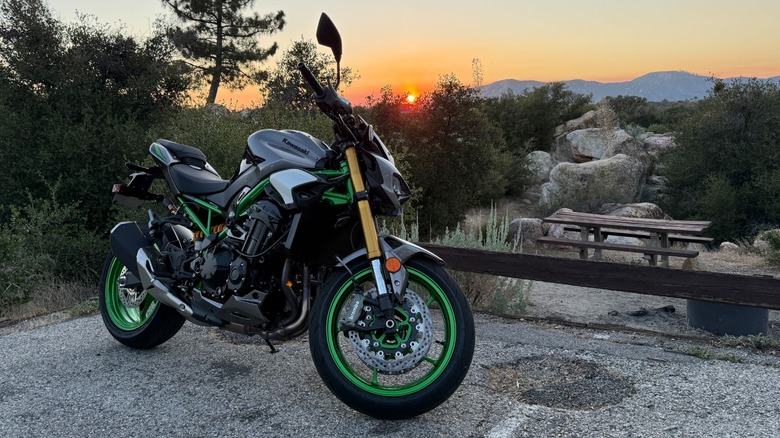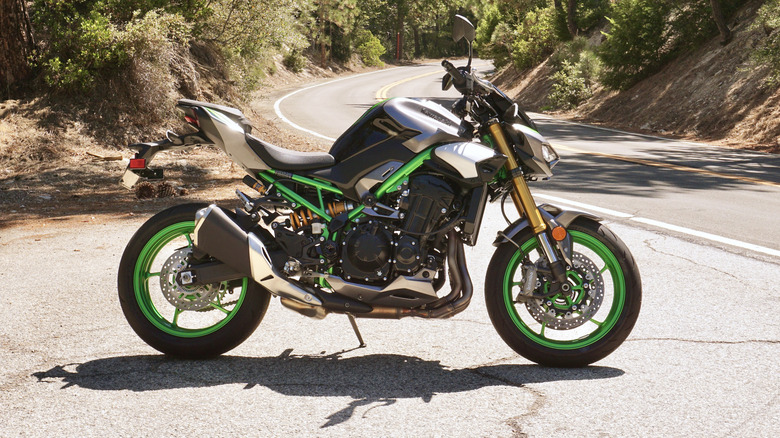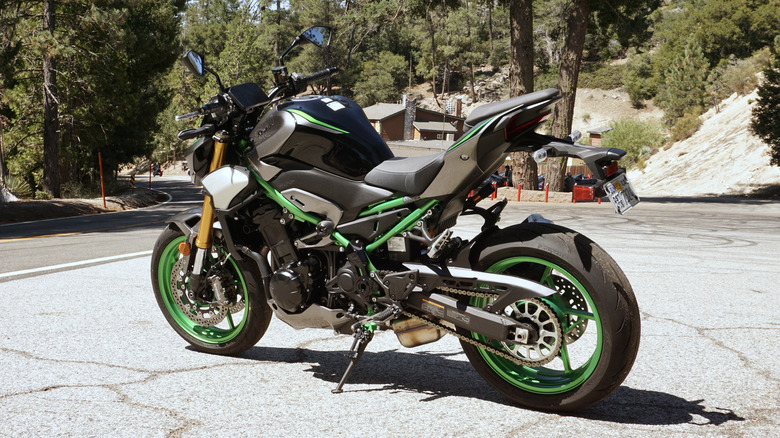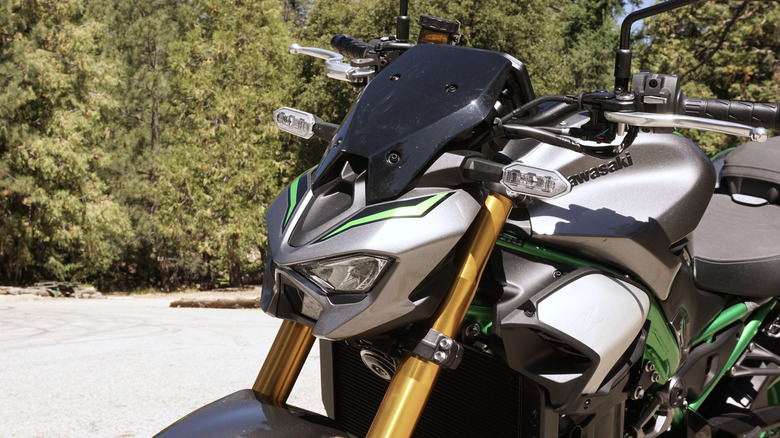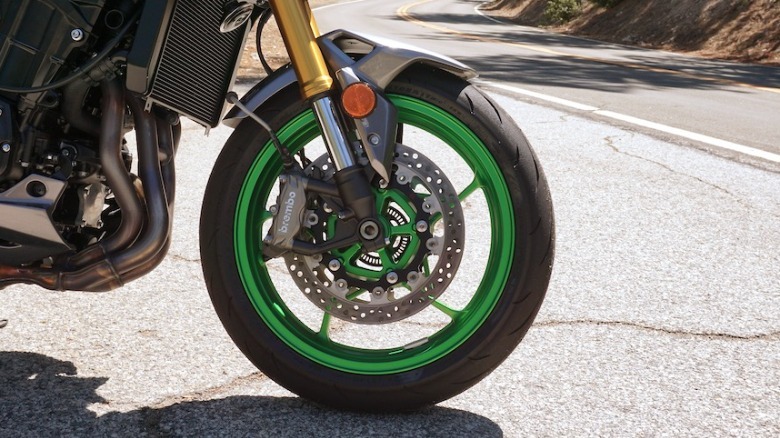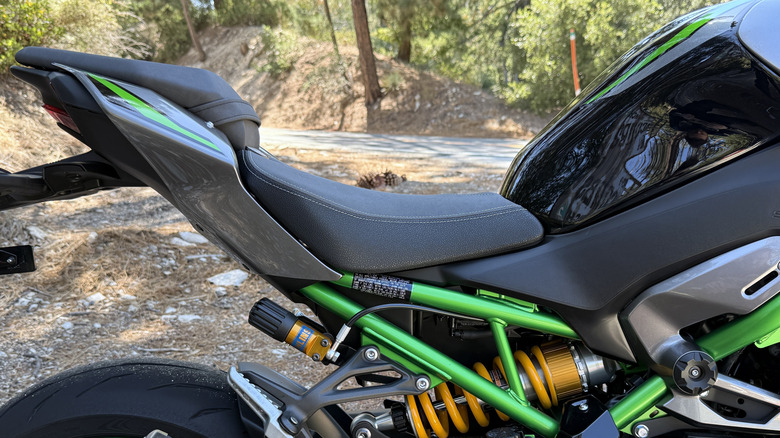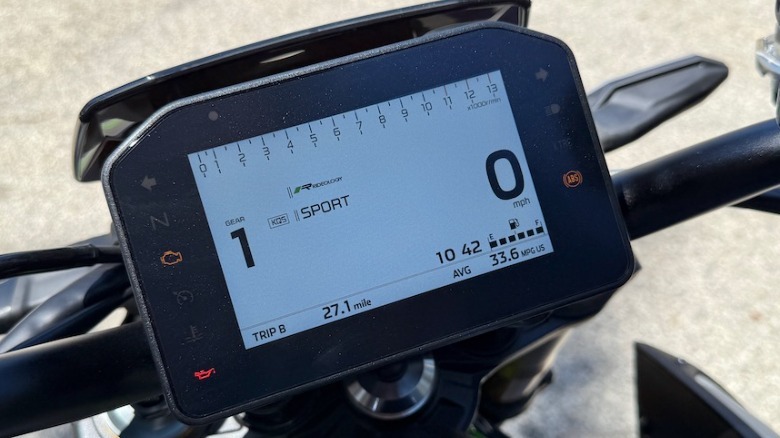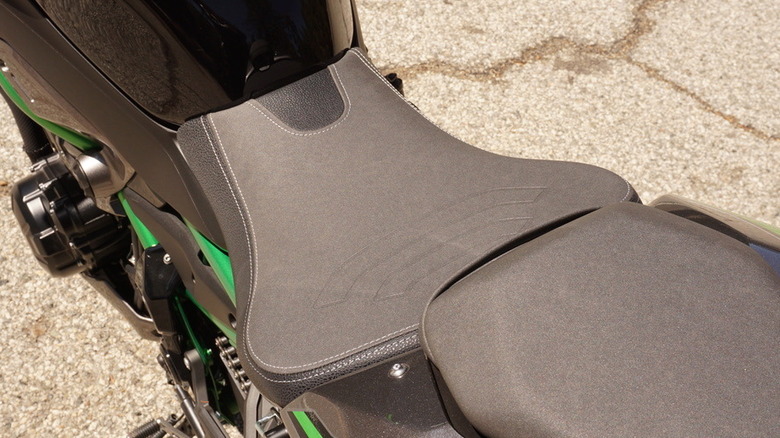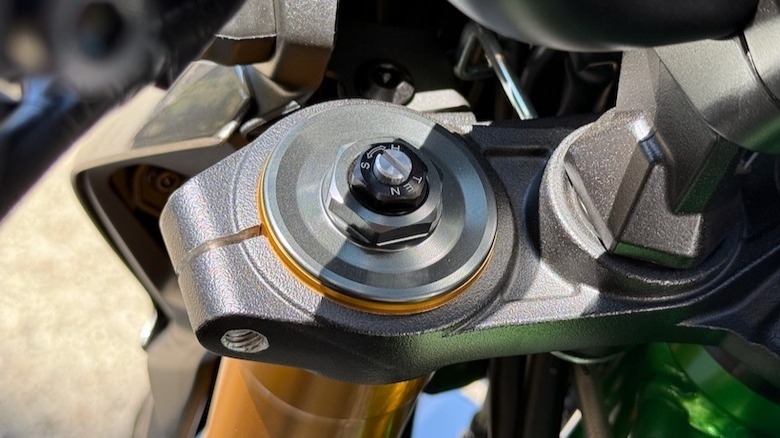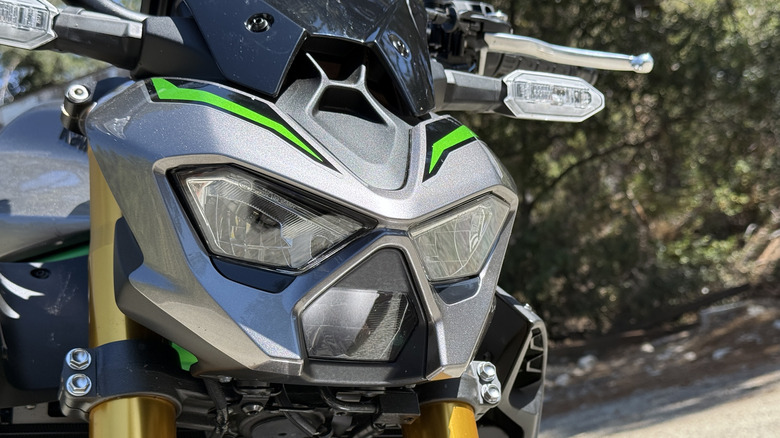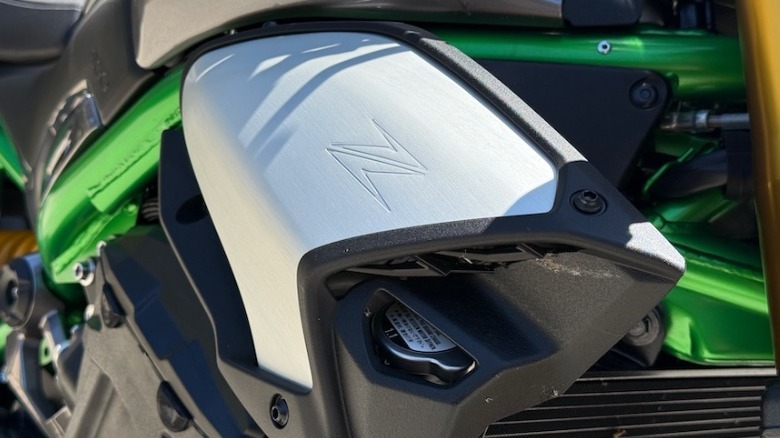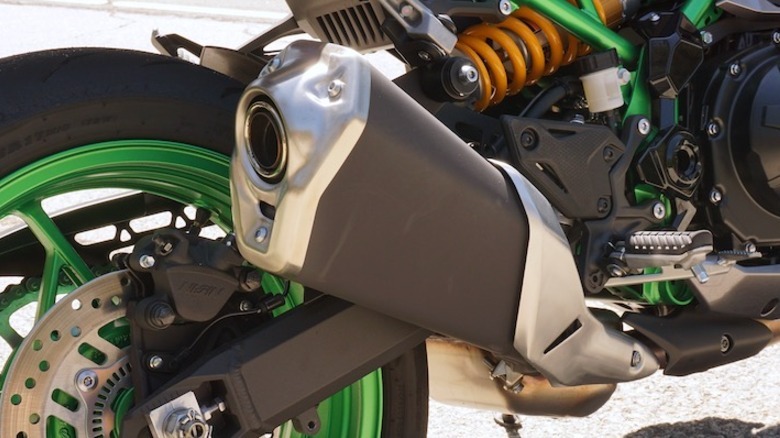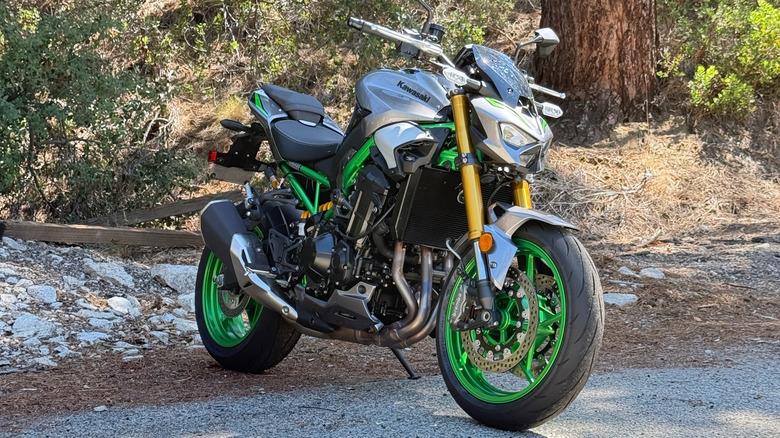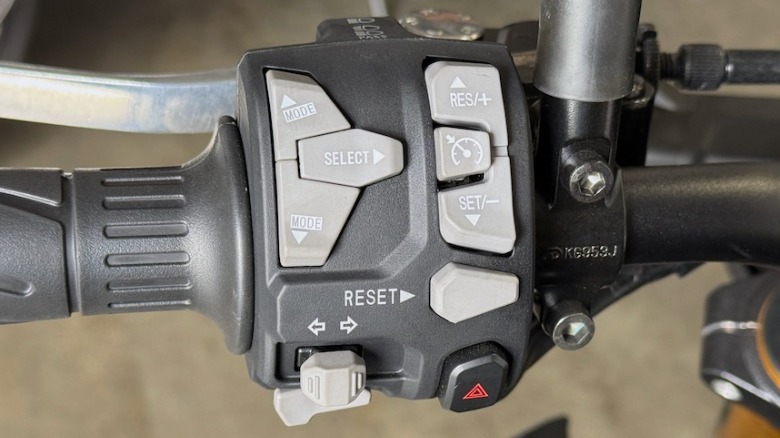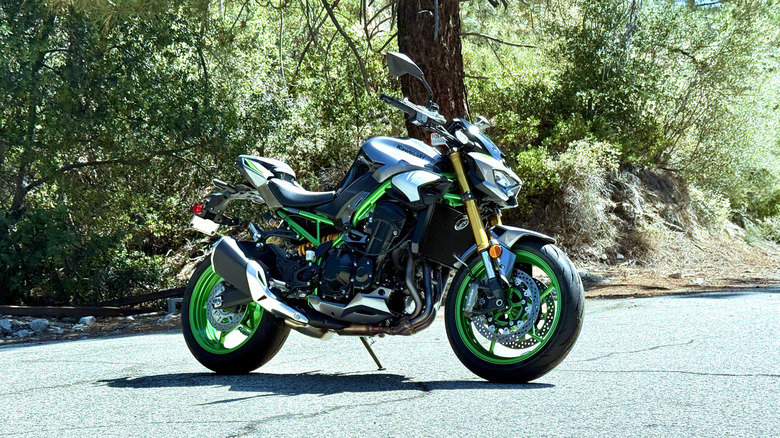2025 Kawasaki Z900 Review: More Than Just A Beginner's Bike
One of the most robust lineups in motorcycle production these days belongs to Kawasaki. From mini bikes like the Z125 Pro, all the way up to top-speed demons like the H2, there's a bike in their warehouse for just about everyone. Right in the middle of their range though, is a naked sport bike that may have flown a bit under your radar. The Z900 isn't quite a liter bike, and it's a bit larger than some of the three-cylinder offerings in its class, so it might go unnoticed by some shoppers — but it certainly shouldn't.
The Z900 is refreshed for 2025 with new styling, changes to the 948cc four-cylinder engine, and updated tech. It's modern, packed with features, and it strikes an excellent balance between comfort and sporty capability. And with all the upgrades, the new Z900 is appealing enough to stand out not just in Kawasaki's broad lineup, but in the competitive class of sport naked bikes.
Base pricing is good, but the SE is worth the upgrade
There are two main versions of the Z900: the standard bike and the SE. The base Z900 starts out with a pretty impressive feature list for the money, with an MSRP of $9,999 (not including destination fee; Kawasaki doesn't list those). That includes tech like cruise control, traction control, selectable power modes, smartphone connectivity via the Rideology App, and the 5-inch TFT display that houses the Z900's gauges. It also includes Kawasaki's Inertial Measurement Unit (IMU) which powers features like their cornering management function, changing braking and engine power to help keep corner entry and exit smooth.
For hardware, the standard Z900 also gets a quick shifter, LED headlights and taillights, and Dunlop Sportmax Q5A tires. The SE is a bit more, with a starting price of $11,849. For the extra cash, Kawasaki throws in Brembo front brakes and stainless-steel braided lines, an Öhlins rear shock with remote adjustability, front suspension compression adjustability (with gold front forks), and a two-tone seat. That's a pretty robust set of added features for $1,850 more.
Revising the engine for better fuel economy
The Z900 is powered by a relatively unique engine: a 948cc four-cylinder inline-four. Most bikes that bother to go above 900ccs typically pay full freight and go for 1,000ccs instead. That makes the Z900 a bit less punchy than some rivals like the Honda CB1000 Hornet SP or the Yamaha MT-09, especially in the higher RPM range. Kawasaki has updated the tuning and some of the hardware on the 2025 Z900 to improve efficiency and reduce emissions, but they say the result is more linear power delivery too.
Without riding both generations of the Z900 back-to-back, it's hard to make that distinction, but the current powertrain is thoroughly enjoyable. The engine produces 123 horsepower at a peak of 9,500 rpm and 73.1 lb-ft of torque at 7,700 rpm. The 123 horsepower will have you doing triple-digit speeds in short order, but that's not where the Z900's character comes from. Instead, it's the beefy torque, much of which comes on earlier than 7,700 rpm.
Moving through the gears with ease
Getting used to the Z900, I did a bit of cruising around in third or fourth gear, riding through the city in the middle-of-the-range Road ride mode, then up onto the highway at higher speeds. Even when I was lugging around, low in the RPM range, the Z900 gave me a strong dose of torque on command. With a twist of the throttle I'd get a surge of power — nothing violent or hair-raising, but certainly immediate. Sport mode is a bit more responsive, but still smooth, consistent, and progressive with the application of power as you approach the redline.
This might not be the kind of power delivery that everyone shopping for a big naked bike is looking for, but for me, it felt excellent; particularly because of how easy it was to acclimate. The Z900 doesn't have the sort of threatening power you get with some larger-displacement naked bikes, or even the twitchy power associated with some three-cylinder bikes in this class.
The six-speed transmission was a treat during my test too. The quick shifter operated with just a subtle flex of my big left toe, slipping into a higher or lower gear without any difficulty whatsoever. Stopping is easy too, thanks to a brake lever and pedal that provide firm feedback and quick responses to inputs. The Brembo front discs are borrowed from Kawasaki's Z H2 Hypernaked bike, and they clamp just as hard as you'd expect them to.
A sporty riding position
For my frame, and for sporty riding, the Z900's riding position was near-perfect, though it took some getting used to. The first time I swung my leg over the back of the Z900 and slid into the saddle, I felt like I was too far forward. I had to look down considerably to see the TFT screen where the gauges were displayed. The view forward from the inside of my helmet was all roadway and sky above unless I purposefully angled my head downwards.
To remedy this (I like seeing the gauges/screen when I ride) I leaned forward a bit, moved my chest a bit closer to the gas tank, and this gave me a better view. The side effect was my legs were now closer to my chest and a bit more scrunched-up than I would've liked. This settled-in riding position turned out to be where I rode the Z900 for the rest of my time with the bike. I wasn't quite over the handlebars, but the seat height and the close vicinity of the handlebars made me feel completely in control without adding lots of pressure to my wrists. I was able to connect corners, easily stand the bike up then lean it back over, and smoothly transition at a fast pace on just about any section of road.
Comfort over distance
Leaning a bit forward, unable to see the Z900's gauges without a big downward movement of my head, wasn't the best fit on longer rides. I was able to adjust, lean back a bit and settle in for long freeway stints, but this is where we get back to the scrunched-up-legs bit. At 5-foot-9, this was only a minor inconvenience for me, but for taller riders, I can imagine it would be a bit more than annoying.
Thankfully, a lot of other virtues mean the Z900 was otherwise comfortable on the highway. The seat is particularly well-padded, wide, and upholstered with excellent fabric. Even after hundreds of miles of riding over just a few days, my backside remained unbothered. The suspension was forgiving, soaking up small bumps on the highway and in the city. With the adjustable suspension set just a couple clicks from the bike's softest settings, there was a bit of nose-dive under hard braking, but more a soft absorption of bumps — just the way I like it. While it wouldn't be my first choice for a cross-country road trip, the Z900 is a bike I'd happily use as both a daily commuter and a weekend canyon carver.
Sights and sounds
Beauty is, as the saying goes, in the eye of the beholder. And to my eyes, the Z900 has near-perfect streetfighter styling. The new, more-slender headlights with their three-piece configuration look particularly sleek. The bulging aluminum shrouds on the size of the Z900 give it a premium vibe, as does Kawasaki's purposeful shift to remove plastic components and replace them with metal.
The shortened tail section makes the bike look smaller than it is and the color combinations of green, gold, gray and black on the SE model are particularly pleasing to the eye. Removing some of the green stripes from the body work would make it look even better in my opinion (and that's easy, because those are just stickers).
The one low point in styling is the large exhaust muffler – not an uncommon eyesore on stock bikes, but one I'd almost immediately replace if the bike were mine and not on loan. The exhaust note isn't particularly evocative either. The four-cylinder engine does rev nicely and it has the sort of bass-heavy note you expect from a liter bike, but the Z900 is no high-RPM screamer like it's stable-mate the blisteringly-fast ZX-10R.
Tech that makes the ride easier
I've been resistant to cruise control on motorcycles, but after a recent 1,100-mile road trip on a Gold Wing, I've embraced the technology more. Long rides — especially on bikes with sporty riding positions like the Z900 — can be tiring, and cruise control certainly reduces that fatigue. On the Z900, the cruise control worked well, maintaining speed without much variation up or down hills. I could disengage cruise control with the buttons or by tapping the brake, but I could also disengage it by twisting the throttle forward the tiniest bit – an excellent inclusion.
Other modern tech included on the Z900, like traction control, computer-enhanced ABS, and corner management, all worked quietly and without much intrusion. Once or twice, I accelerated hard enough to feel traction control manage slip on the rear tire, but it never cut power completely. Instead of an intrusive restriction, it felt like a light helping hand. ABS was similarly easy-going, only intruding when I provided some seriously aggressive brake pressure.
According to Kawasaki, the ABS system uses the IMU's sensors to calculate lean angle and adjust the amount of brake force applied mid-corner — especially important if you come across an obstacle mid-corner and need to stop quickly. Thankfully, that didn't happen during my test of the Z900, but it's nice to know that bit of tech is there.
2025 Kawasaki Z900 Verdict
The Honda CB1000 Hornet SP is a strong competitor for the Z900, but the Honda is slightly more expensive ($10,999 plus $775 destination) up against the standard Z900, not to mention it lacks features like cruise control. Plus, having just ridden the CB1000 Hornet, I'd rather have the Z900, even with less power. The Z900's narrower tank is easier to wrap my legs around and with less-twitchy throttle application, I'm more likely to enjoy a ride on the Kawi — it's easier to ride quickly.
Riders should also consider the Yamaha MT-09, which is properly priced ($10,799 plus $750 destination and $625 supply chain surcharge) to compete with the Z900, and with similar features, though it uses the CP3 three-cylinder instead of a four-banger.
The 2025 Kawasaki Z900 does not assault your senses and that's a virtue in my book. With the rider aids turned on, it's approachable and easy to ride even for beginners, but still properly quick. It moves through corners easily, navigating turns like a much lighter bike, but it's able to rip towards the horizon in a hurry via a flick of the wrist. Turn off the rider aids and it will happily pick the front wheel up off the ground and engage in a bit of hooliganism. But, just as easily, it will return to its natural state as a bastion of accessible speed. Smooth acceleration, a comfortable ride, an excellent seat, and lots of modern tech make it an excellent choice in the class.
